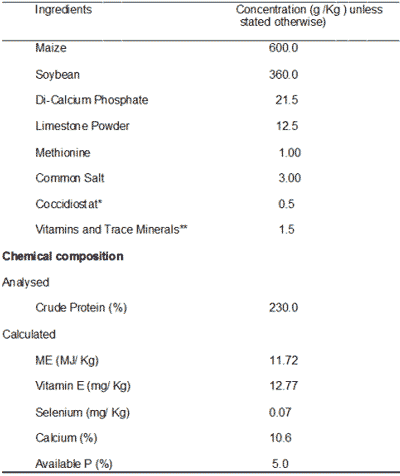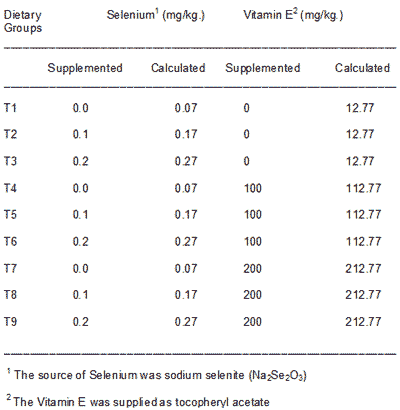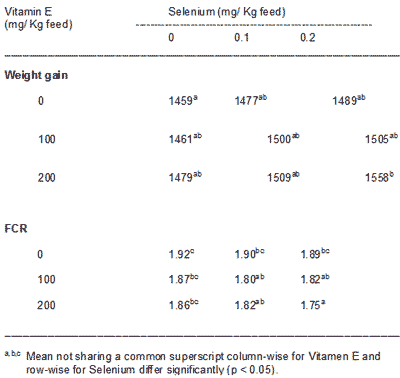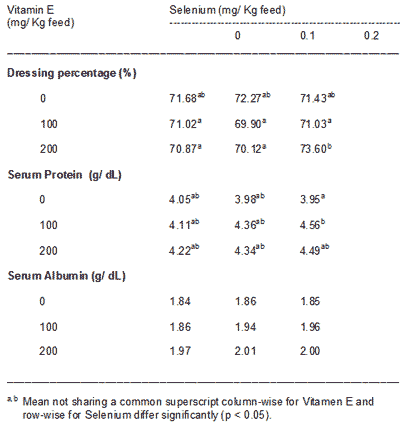



Evaluation of Therapeutic Potential of Vitamin E and Selenium in Improving Growth Performance in Broilers
Dietary supplementation of vitamin E and selenium improved growth performance, according to H. Singh, R. Kaur and S. Sodhi of the College of Veterinary Science, Guru Angad Dev Veterinary & Animal Sciences University in Ludhiana, India.Abstract
An experiment was conducted with 252 broiler chicks using maize–soya diets with concentration of supplemental vitamin E varying from 0 to 200 mg/kg and selenium concentration varying from 0 to 2 mg/kg diet either alone or in combinations from 1 to 42 days of age to study their effect on growth performance and biochemical profile. Chicks receiving supplements of 200 mg vitamin E per kg and 0.2 mg selenium per kg had significantly higher body weight gains and feed conversion efficiency. Consistent with these findings were increased serum concentration of total protein. However, there was no significant change in concentration of albumin. The dressing percentage was also higher in the chicks supplemented 200 mg per kg vitamin E and 0.2 mg per kg selenium. The results suggest that dietary supplementation of vitamin E and selenium improved growth performance, which might result from increased immunocompetence and thus ability to resist adverse effects of sub-clinical diseases.
Introduction
It is well documented that growth and viability of chicks improve with vitamin E supplementation (Serman et al., 1992; Choi et al., 1995). Vitamin E has several functions in biological systems primarily as an intercellular and intracellular antioxidant agent that prevents oxidation of unsaturated lipids within cells. It has protective effect on cell membranes and deficiency results in damage to blood vessels and changes in capillary permeability. It enhances disease resistance in chicken by improving action of phagocytic cells during pathogenic invasion into body. Selenium promotes feathering, thermoregulation, fertility and hatchability. It also improves antioxidant status of birds and promotes immunocompetence and lowers ascites induced mortality (Colnago et al., 1984).
Vitamin E and selenium appear to participate in similar nutritional and biochemical relationships. They act as immuno-stimulatory agents and protect against oxidative damage. Free radicals are scavenged by vitamin E as a first line of defence (Choct and Naylor, 2004) and thereby glutathione peroxidase of which selenium is a part. Nutritional deficiencies of vitamin E or selenium or both result in depression in body weight, increased mortality and decreased performance including immune dysfunction. The present study was to investigate using broiler chicks the effect of dietary supplementation of vitamin E and selenium alone or in combination on growth performance, feed conversion efficiency and dressing percentage.
Materials and Methods
Two hundred and fifty-two broiler chicks were obtained from local hatchery and maintained in brooding/rearing pens. Chicks had free access to water and experimental diets formulated with three levels of supplemental selenium (0, 0.1 and 0.2 mg/kg diet from sodium selenite) and three levels of vitamin E (0, 100 and 200 mg/kg diet from tocopheryl acetate) to basal diet (Table 1) containing selenium 0.07 mg/kg and vitamin E 12.77 mg/kg. Crude protein (CP) and metabolisable energy (ME) contents of the basal diets were 230 g/kg and 11.72 MJ/kg respectively, as per the requirements of Bureau of Indian Standards (BIS, 1992). Crude protein contents of the diets were estimated as per the methods of AOAC (2000). Chicks were wing banded and distributed on equal body weight basis into eighteen groups of 14 chicks (seven males and seven females) each. Each diet was offered to two replicate groups. The experimental design was a factorial randomised block design. There were nine dietary treatment groups (Table 2).
Table 1. Formula composition of basal diets


Table 2. Supplemental levels of selenium and vitamin in experimental diets

Feed intake
Each group of chicks was offered weighed, an adequate amount of feed each day. The average weekly feed intake in each group was calculated by dividing the total feed intake in that week by the number of chicks, taking into account the mortality, if any.
Body weight gain
Chicks were weighed individually at weekly intervals in all the groups. Average body weight and body weight gain at weekly intervals and for the entire experimental period (1-6 weeks) was then calculated for each experimental group.
Feed conversion efficiency
It is expressed as feed conversion ratio (FCR) and was calculated as grams of feed consumed per gram of body weight gain, with correction for mortality and weight loss.
FCR = Feed Intake (g)/Body Weight gain (g)Biochemical profile
The blood sample of two birds (one male and one female) from each replicate was taken and serum was separated. Total proteins (Lowry et al., 1951) and serum albumins (Doumas et al., 1971) were estimated from these samples.
Statistical profile
Differences between chicks arising from treatments were examined by using analysis of variance (Snedecor and Cochran, 1968) with a multiple range test for comparing means for significant differences. Significance was at P<0.05 unless otherwise stated.
Results and Discussion
The body weight gain (Table 3) showed that vitamin E and selenium supplementation were related with body weight gain. The maximum body weight gain was achieved with diet supplemented with 200 mg vitamin E per kg and 0.2 mg selenium per kg. The results are in agreement with the findings of Swain et al. (2000) who reported that supplementation of vitamin E and selenium improves the health and overall growth performance in broilers. The findings of Aravind et al. (2001) also revealed that combinations of organic selenium and vitamin E gave consistently superior results for growth traits.
Table 3. Effects of supplementing selenium and vitamin E
on weight gain and feed conversion ratio

Increased vitamin E and selenium concentration was associated with increased feed conversion ratio (Table 3). A maximal value for FCR was achieved with the diet supplemented 200 mg vitamin E per kg and 0.2 mg selenium per kg. The results are in accordance with Brytskov et al. (1980) who reported better feed conversion efficiency in broilers receiving diet supplemented with vitamin E.
Vitamin E and selenium supplementation significantly (p<0.05) affected the dressing percentage (Table 4). The maximum dressing percentage was achieved with the diet supplemented 200 mg vitamin E per kg and 0.2 mg selenium per kg. Aravind et al. (2001) also reported improvement of dressing percentage with supplementation of vitamin E and selenium in the diet of broilers. However, Bhat et al. (1999) revealed non-significant improvement in dressing percentage of broilers with vitamin E supplementation.
Table 4. Effects of supplementing selenium and vitamin E
on dressing percentage and biochemical profile

The serum protein level (g/dL) was significantly (p < 0.05) affected by the supplementation of vitamin E and selenium (Table 4). However, the dietary supplementation of selenium, vitamin E alone or their different combinations failed to affect total serum albumin levels significantly (p<0.05) in broiler chicks. These observations confirm earlier studies conducted by Cetin et al (2002) that dietary supplementation of organic selenium caused significant improvement in total serum proteins (g/dL) in broilers. The increase in total proteins in present study could be attributed to increased production of immunoglobulins on supplementation of broiler chicks with vitamin E and selenium as observed in experimental study from our laboratory (Singh et al., 2006).
From the results of present studies, it is evident that vitamin E and selenium act synergistically in improving growth performance of broiler chicks. In view of various challenges faced by young chicks, it therefore seems highly desirable to have nutritional manipulation of broiler diet and to have additional supplements of dietary vitamin E and selenium have beneficial effects on growth as well as immunocompetence of broiler chicks.
References
- AOAC. 2000. Official methods of analysis 17th edition, Association of official analytical chemists, Washington.
- Aravind K.L., Gowdh C.V., Manjunath B.P., Rajendera A.Y.and Ganpule S.P. 2001. Indian J Poult Sci. 36 (1): 58-62.
- Bhat G.A., S.A. Wani and T.A.S. Gawai. 1999. Ind J Poult Sci 34 (1): 86-88.
- Brystskov V.E., Kpyukov V.S., Egorov I.A. and Avacumov V.M. 1980. Nutr. Abstr. Rev. (Series B) 51: 6724.
- Cetin M., Deniz G., Polat U. and Yalcin A. 2002. Veteriner Fakultesi Dergisi, Uludag Universitesi 21: 59-63.
- Choct M. and Naylor A.J. 2004. Asian Aust J Anim Sci 17: 1000-1007.
- Choi Y.K., Jung K.K., Chae K.Y., Jang I., Lee B.D. and Nahm K.H. 1995. American J Anim Sci 8 (1): 379-85.
- Colnago G.L., Jensen L.S. and Long P.L. 1984. Poult Sci 63: 1136-43.
- Doumas B.T., Watson W.A. and Biggs H.G. 1971. Clin Chem Acta 31: 87.
- Lowry O.H., Rosebrough W.J., Furr A.L. and Randall R.H. 1951. J Biol. Chem. 193: 265-75.
- Serman V., Mas N., Marija H. and Mikulec Z. 1992. Krimva 34: 65-69. (CF Nutr. Rev. 63: 622)
- Singh H., Sodhi S. and Kaur R. 2006.Poult Sci 17 (6): 714-719.
- Snedecor G.W. and Cochran W.G. 1968. Statistical Methods 6th Ed., Oxford.
- Swain B.K., Johri T.S., Swain P. and Shrivastav A.K. 2000. Ind J Poult Sci 35 (3): 247-51
The article was first published on FeedInfo.com.
April 2010








